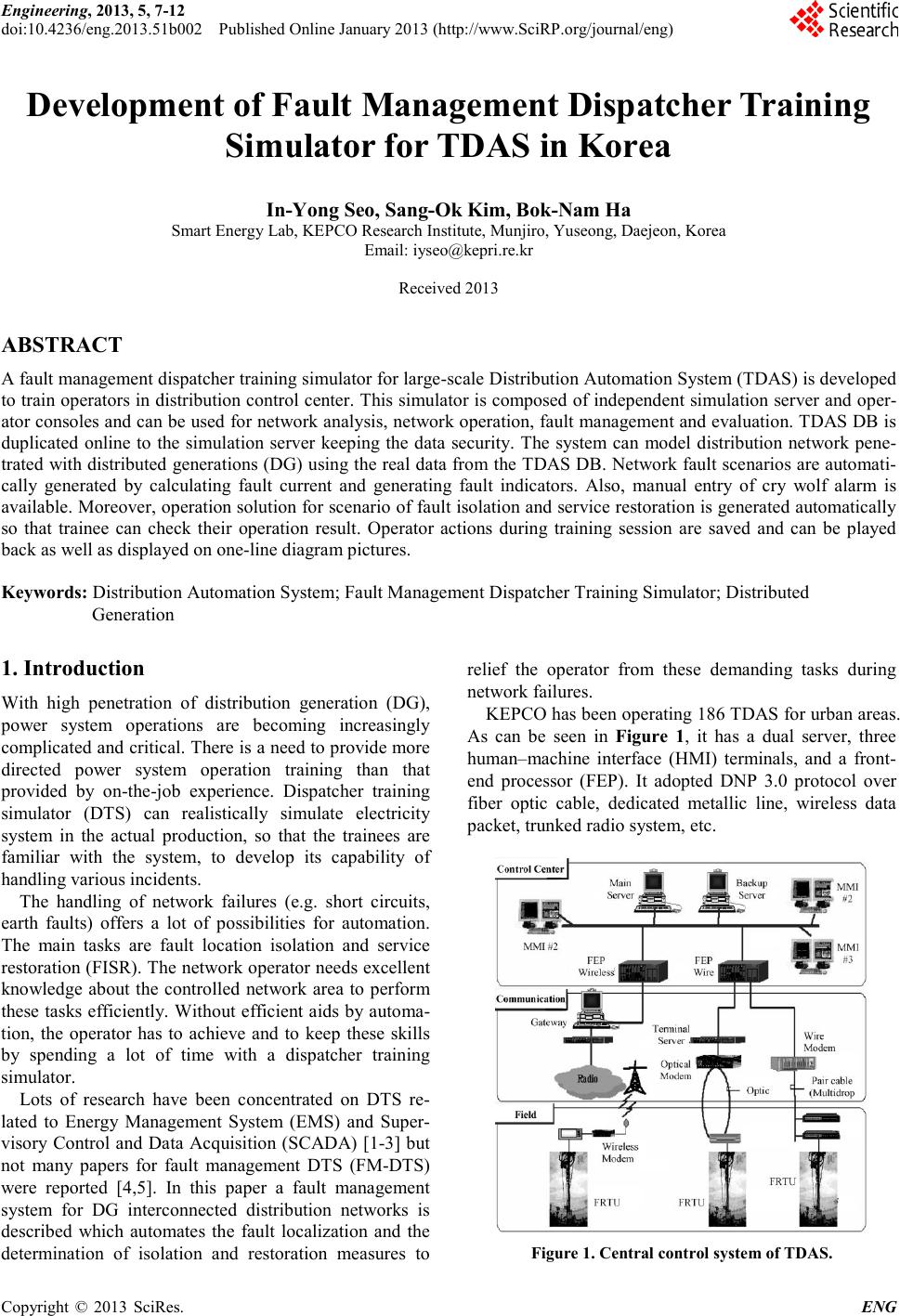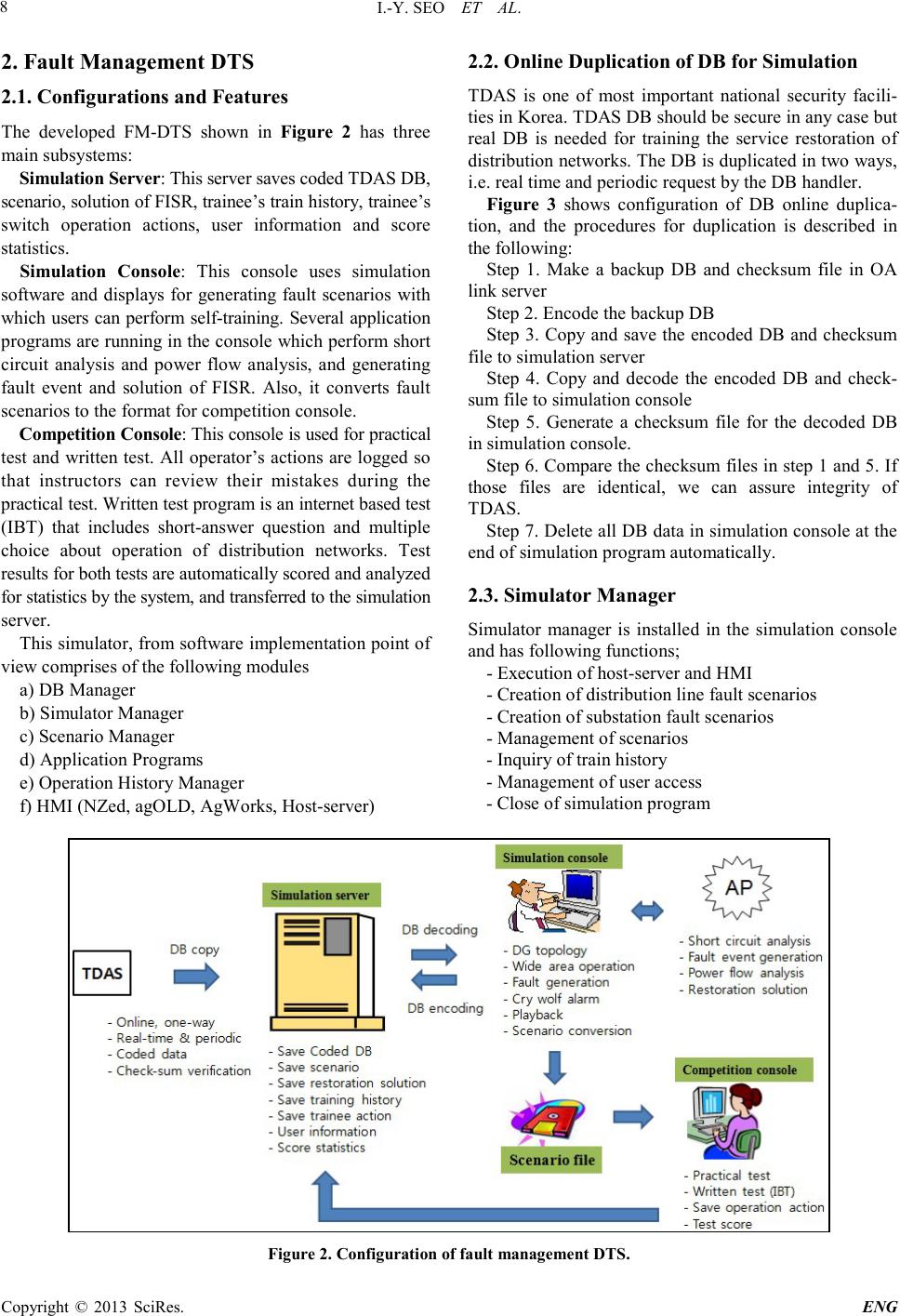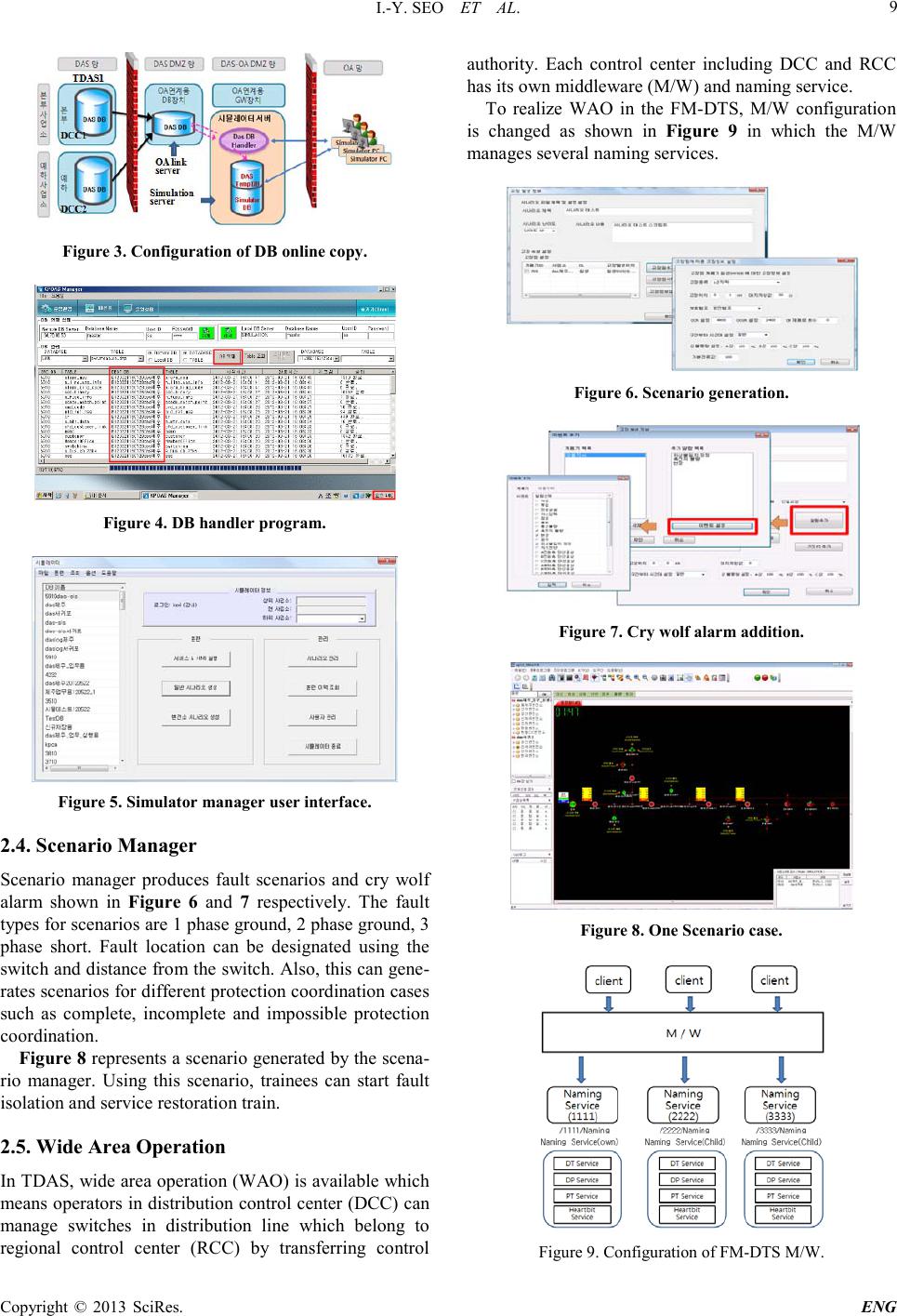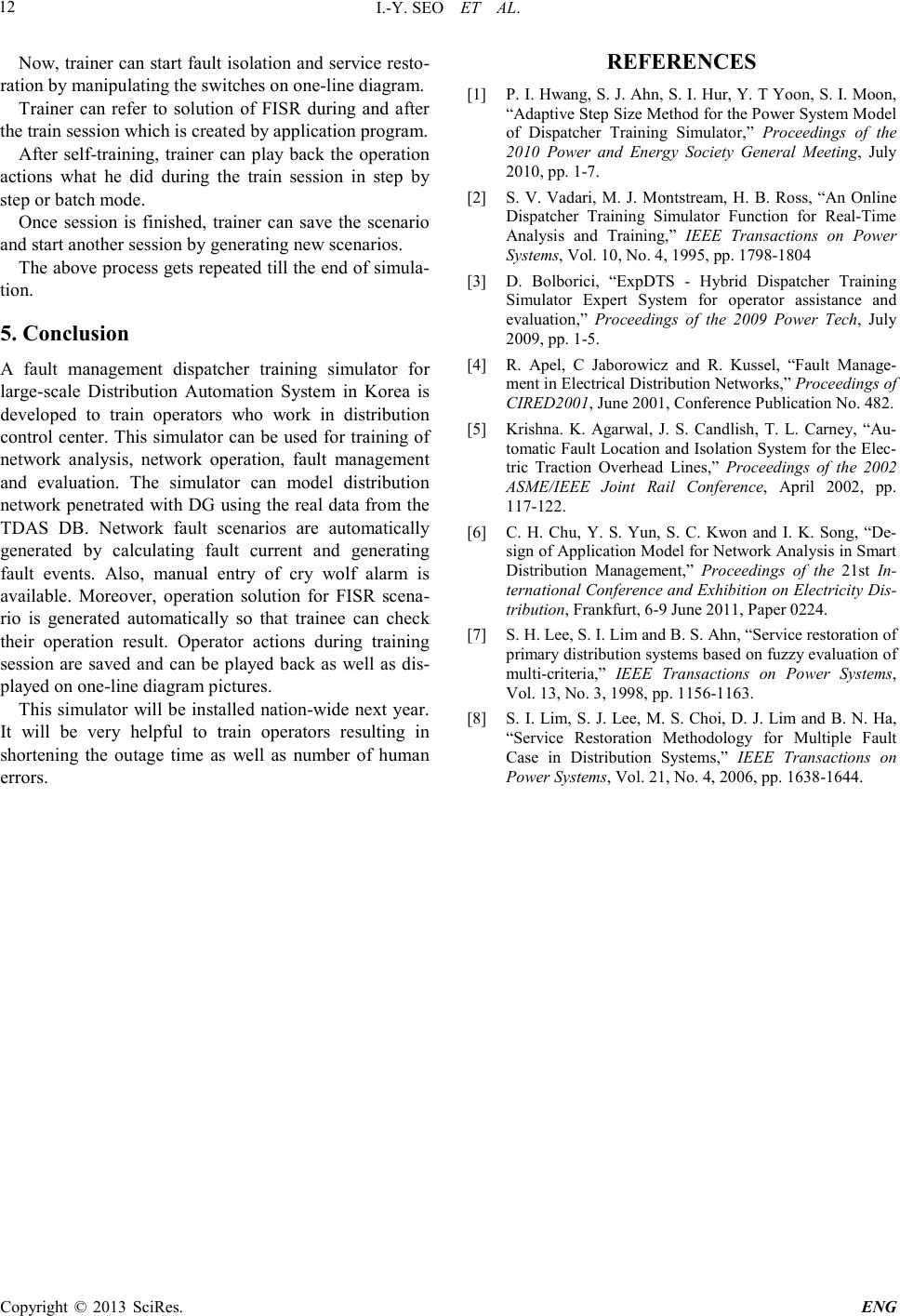Paper Menu >>
Journal Menu >>
 Engineering, 2013, 5, 7-12 doi:10.4236/eng.2013.51b002 Published Online January 2013 (http://www.SciRP . org/journal/eng) Copyright © 2013 SciRes. ENG Development of Fault Management Dispatcher Training Simulator for TDAS in Korea In-Yong Seo, Sang-Ok Kim, Bok-Nam Ha Smart Energy Lab, KEPCO R esearch In s titute, Munjiro, Yuseong , D a e j e on, Korea Email: i yseo@kepri .re.kr Received 2013 ABSTRACT A fault ma nage men t dispa tcher training s i mulator for lar ge-s cale Distribut ion Auto mation Syste m (TDAS) is deve lop ed to train ope rators in distribution control ce nter. T his simulato r is composed of independent simulatio n server and o per- ator consoles and can be used for networ k anal ysis, net wor k op eratio n, faul t ma nageme nt and eval uatio n. TD AS DB i s duplicated online to the simulation server keeping the data security. The system can model distribution network pene- trated with distributed generat ions (DG) using the real d ata from the TDAS DB. Network fault scenarios are automati- cally generated by calculating fault current and generating fault indicators. Also, manual entry of cry wolf alarm is available. Mo reover, op eration solution for scenario of fault isolation and ser vice restoration is generated automatically so that trainee can check their operation result. Operator actions during training session are saved and can be played back as well as displayed on one-line dia gram pictures. Keywords: Distribution Automatio n System; Fault Ma nagement Dispatcher T raining Simulator; Distributed Generation 1. Introduction With high penetration of distribution generation (DG), power system operations are becoming increasingly complicated and critical. There is a need to provide more directed power system operation training than that provided by on-the-job experience. Dispatcher training simulator (DTS) can realistically simulate electricity system in the actual production, so that the trainees are familiar with the system, to develop its capability of handling vari ous incidents. The handling of network failures (e.g. short circuits, earth faults) offers a lot of possibilities for automation. The main tasks are fault location isolation and service restoratio n (FISR). The network operator needs excellent knowledge about the controlled network area to perform these tasks efficiently. Without efficient aids by a u t oma- tion, the operator has to achieve and to keep these skills by spending a lot of time with a dispatcher training simulator. Lots of research have been concentrated on DTS re- lated to Energy Management System (EMS) and Super- visor y Control and Data Acquisition (SCADA) [1-3] but not many papers for fault management DTS (FM-DTS) were reported [4,5]. In this paper a fault management system for DG interconnected distribution networks is described which automates the fault localization and the determinatio n of isolation and restoration measures to relief the operator from these demanding tasks during network failures. KEP CO has been operating 186 TDAS for urban areas. As can be seen in Figure 1, it has a dual server, three human–machine interface (HMI) terminals, and a front- end processor (FEP). It adopted DNP 3.0 protocol over fiber optic cable, dedicated metallic line, wireless data packet, trunked rad io system, etc. Figure 1. C e ntral control system of TDAS.  I.-Y. SEO ET AL. Copyright © 2013 SciRes. ENG 8 2. Fault Management DTS 2.1. Configurations and Features The developed FM-DTS shown in Figure 2 has three main sub systems: Simulat i on Ser ver : This server saves coded TDAS DB , scenario, solutio n of FIS R, trai nee’s trai n histor y, traine e’s switch operation actions, user information and score statistics. Simulation Console: This console uses simulation software and displays for generating fault scenarios with which users can perform self-training. Several application pro grams ar e runni ng in the cons ole whic h per for m short circuit analysis and power flow analysis, and generating fault event and solution of FISR. Also, it converts fault scenarios to the format for competition console. Competition Console: This console is used for practical test and written test. All operator’s actions are logged so that instructors can review their mistakes during the practical tes t. W rit te n te st progr a m is an inter net b a sed te st (IBT) that includes short-answer question and multiple choice about operation of distribution networks. Test results for both tests are a u tomatically scored and analyzed for statistics by the system, and transferred to the simulation server. This simulator, from software implementation point of view co mprises of the following modules a) DB Manager b) Simulator Manager c) Scenario Manager d) Application P rogra ms e) Operation History Manager f) HMI (NZed, agO LD, AgWorks, Host-server) 2.2. Online Duplication of DB for Simulation TDAS is one of most important national security facili- ties in Korea. TDAS DB should be secure in any case but real DB is needed for training the service restoration of distribution networks. T he DB is duplic ated in two ways, i.e. real time and periodic req uest by the DB handler. Figure 3 shows configuration of DB online duplica- tion, and the procedures for duplication is described in the followin g: Step 1. Make a backup DB and checksum file in OA link server Step 2. Encode the backup DB Step 3. Copy and save the encoded DB and checksum file to simulation server Step 4. Copy and decode the encoded DB and check- sum file to simula tion console Step 5. Generate a checksum file for the decoded DB in simulatio n console. Step 6. Compare the c hecks um fil es i n step 1 and 5 . If those files are identical, we can assure integrity of T DAS. Step 7. Delete all DB data in simulation console at the end of simulation program automatically. 2.3. Simulator Manager Simulator manager is installed in the simulation console and has fo llowi ng fu nct ions; - Execution o f host-server and HMI - Creation of distr ibution li ne fault sce nar ios - Creation of s ub station fault sc e nar ios - Management of scenarios - Inquiry of train history - Management of user access - Close of simulation program Figure 2. Configuration of fault management DTS.  I.-Y. SEO ET AL. Copyright © 2013 SciRes. ENG 9 Figure 3. Configur a tion of DB online copy. Figure 4 . DB handler prog ram. Figure 5. Simulator manag er user interf ac e. 2.4. Scenario Manager Scenario manager produces fault scenarios and cry wolf alarm shown in Figure 6 and 7 respectively. The fault types for scenarios are 1 phase ground, 2 phase ground, 3 phase short. Fault location can be designated using the switc h and d istance from t he swit ch. Al so, this can gene- rates scenarios for different protection coordination cases such as complete, incomplete and impossible protection coordination. Figure 8 represents a scenario generated by the scena- rio manager. Using this scenario, trainees can start fault isolation and service restora tion train. 2.5. Wide Area Operation In TDAS, wide area operatio n (WAO) is available which means oper ators in distribution control center ( DCC) can manage switches in distribution line which belong to regional control center (RCC) by transferring control authority. Each control center including DCC and RCC has its own middleware (M/W) and naming service. To realize WAO in the FM-DTS, M/W configuration is changed as shown in Figure 9 in which the M/W mana ges several naming services . Figure 6 . Scenario generation. Figure 7. Cry w olf alarm addi ti o n. Figure 8 . One Scenario c ase. Figure 9. Configuration of FM-DTS M/W.  I.-Y. SEO ET AL. Copyright © 2013 SciRes. ENG 10 3. Application Programs of FM-DTS 3.1. Short Circuit Analysis Program This application calculates short circuit current in DG interconnected distributio n networ k system ba sed on IEC 60909 standards. Several kinds of fault currents at dif- ferent time instants after fault occurrence can be gener- ated. This module is composed of Networ k Connectivity Processor (NCP) and Short Circuit Analysis (SCA) [6]. The flowchart for fault current calculation is shown in Figure 10. NCP: This application performs the function changing the state of system topology, presented to node state on the kind of b reaker o r switch, into the form of ‘bus’ using the open or close state of those kinds. Also, the topological island and t he equipm ent st ate( L i v e or Dead ) are classif ied . SCA: Based on positive, negative and zero sequence impedance, the fault current for the each section of the power distribution system is calculated according to IEC 60909 in case of fault occurrence. Figure 10. Flowchart of short-circuit current calculation. 3.2. Automatic Service Restoration Program This program which utilized the algorithm in [7] gene- rates operation procedures for fault isolation and system restoration so that trainee can perform self-tr aini ng refe r- ring to those procedures. The proposed restoration strat- egy consists of two steps: Candidate Set Generation and Fuzzy Decision Making. The fault is classified in 6 classes as shown in Figure 11, i.e., Self Restoration, Single Group Restoration (SGR), Double Group Restora- tion (DGR), Triple Group Restoration (TGR), Single Group & Level-2 Load Transfer ( S GRLT), Double Group & Le vel -2 Load Transfer (DGRLT). The Fuzzy rule makes decisions to minimize the number of switch- ing, live load transfer, and to balance the load of the network [8]. Figure 12 shows FISR solution produced by this pro- gram (a) and operation actions manipulated by trainer (b). The solution is separated into several fault areas to be restored because the ope ration list is long. And it shows 3 solution candidates from the highest priority for each area. 3.3. Topology Considering DG Network topology for FM-DTS is developed to prevent islanding operation of DGs in distribution network. If any switch installed in source side changes to open, all the vacuum circuit breakers (VCB) of DG after the switch are tripped, while in case of DAS only energized status of line after the switch will be dead. Figure 11. Six basic restoration schemes (a)Self-restoration. (b)SGR (c)DGR (d)TGR. (e)SGR_LT (f)DGR_LT.  I.-Y. SEO ET AL. Copyright © 2013 SciRes. ENG 11 Figure 1 2. FLIS pr ocedure (a) Solut ion (b) Play bac k. Figure 13. An example of network topology. Figure 13 shows an example of DG topology. When switch G2 is open, only VCB2 changes to trip and lines after G2 will be d e-energized, while the status o f DG2 is unchanged. 4. Operation The simulator is implemented on a HP workstation with Windows 2003 Server operating system and MS-SQL Server 2008. The MMI is XP window based one with MS-SQL Server 2008. Figure 14 shows a simulatio n flow chart of this simulator. A brief description of running of the simulator is as follows: To star t the simulatio n proces s, the si mulator re ads the static data of the network over which simulation i s to be performed. Users input all fault information that is need to define the fault such as t ype of fault, fault location, r esistance to ground, etc. W ith these infor mation, applicatio n progra m calculates fault currents, and generates fault indicator (FI) at each switches automatically. After scenario is generated, instructor can modify the scenario by adding cry wolf alarms like communication error, battery low of FRT U, switch open etc. Figure 14. Flowchart of simulation.  I.-Y. SEO ET AL. Copyright © 2013 SciRes. ENG 12 Now, trainer can start fa ult isola tion and service resto- ration by manipulating the switche s on one-line diagra m. Trainer can refer to solution of FISR during and after the train session which is created b y application program. After self-training, trainer can play back the operation actions what he did during the train session in step by step or batch mode. Once session is finished, trainer can save the scenario and st art another session by gener ating new scenarios. The above process gets r epeated till the end of simul a- tion. 5. Conclusion A fault management dispatcher training simulator for large-scale Distribution Automation System in Korea is developed to train operators who work in distribution control center. This simulator can be used for training of network analysis, network operation, fault management and evaluation. The simulator can model distribution network penetrated with DG using the real data from the TDAS DB. Network fault scenarios are automatically generated by calculating fault current and generating fault events. Also, manual entry of cry wolf alarm is available. Moreover, operation solution for FISR scena- rio is generated automatically so that trainee can check their operation result. Operator actions during training session are saved and can be played back as well as dis- played on one-line diagram pic tures. This simulator will be installed nation-wide next year. It will be very helpful to train operators resulting in shortening the outage time as well as number of human errors. REFERENCES [1] P. I. Hwang, S. J. Ahn, S. I. Hur, Y. T Yoon, S. I. Moon, “Adaptive S tep Size M eth od for the Po wer Syste m Mod el of Dispatcher Training Simulator,” Proceedings of the 2010 Power and Energy Society General Meeting, July 2010, pp. 1-7. [2] S. V. Vadari, M. J. Montstream, H. B. Ross, “An Online Dispatcher Training Simulator Function for Real-Time Analysis and Training,” IEEE Transactions on Power Systems, V ol. 10, No . 4, 1995, pp. 1798-1804 [3] D. Bolborici, “ExpDTS - Hybrid Dispatcher Training Simulator Expert System for operator assistance and evaluation,” Proceedings of the 2009 Power Tech, July 2009, pp. 1-5. [4] R. Apel, C Jaborowicz and R. Kussel, “Fault Manage- ment in Electrical Distribution Networks,” Proceedings of CIRED2001, June 2001, Conference Publication No. 482. [5] Krish na. K. Agarwal, J. S. Candlish, T. L. Carney, “Au- tomatic Fault Location and Isolation System for the Elec- tric Traction Overhead Lines,” Proceedings of the 2002 ASME/IEEE Joint Rail Conference, April 2002, pp. 117-122. [6] C. H. Chu, Y. S. Yun, S. C. Kwon and I. K. Song, “De- sign of Application Model for Network Analysis in Smart Distribution Management,” Proceedings of the 21st In- ternational Conference and Exhibition on Electricity Dis- tribution, Frankfurt, 6-9 June 2011, Pape r 02 24 . [7] S. H. Lee, S. I. Lim and B. S. Ahn, “Ser vi ce r es toration of primary distribution systems based on fuzzy evaluation of multi-criteria,” IEEE Transactions on Power Systems, Vol. 13, No. 3, 1998, pp. 1156-1163. [8] S. I. Lim, S. J. Lee, M. S. Choi, D. J. Lim and B. N. Ha, “Service Restoration Methodology for Multiple Fault Case in Distribution Systems,” IEEE Transactions on Power Systems, Vol. 21, No. 4, 2006, pp. 1638-1644. |

